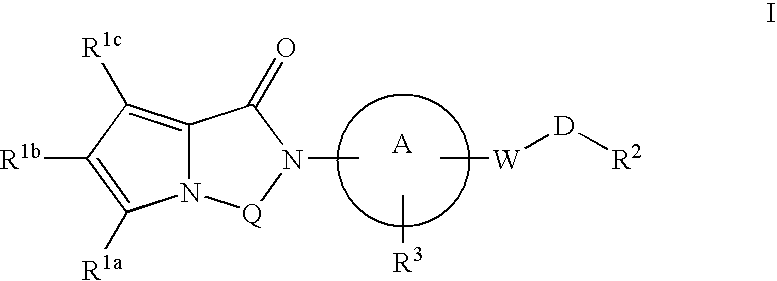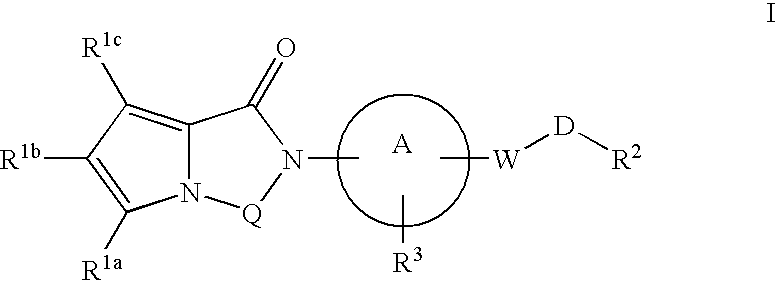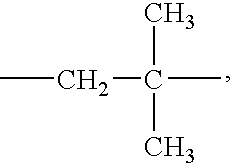Melanin concentrating hormone receptor-1 antagonists
a technology of concentrating hormone and receptors, which is applied in the direction of drug compositions, biocides, metabolic disorders, etc., can solve the problems of increased food intake, weight loss, and decreased feeding in diet-induced obese mi
- Summary
- Abstract
- Description
- Claims
- Application Information
AI Technical Summary
Benefits of technology
Problems solved by technology
Method used
Image
Examples
example 1
Preparation of 7-(4-chlorophenyl)-2-(3-methoxy-4-(2-(pyrrolidin-1-yl)ethoxy)phenyl)-3,4-dihydropyrrolo [1,2-a]pyrazin-1(2H)-one trifluoroacetic acid salt
[0060]
Step A. Preparation of methyl 4-(4-chlorophenyl)-1H-pyrrole-2-carboxylate
[0061] To a stirred DMF solution (40 mL) containing methyl 4-bromo-1H-pyrrole-2-carboxylate (1.0 g, 4.9 mmol), commercially available from Bionet, and Pd(Ph3)4 (195 mg, 0.17 mmol) was added Na2CO3 (1.3 g, 12.52 mmol) (dissolved in minimum amount water) and 4-chlorophenyl boronic acid (0.85 g, 5.43 mmol) under Ar. The mixture was degassed with Ar prior to stirring overnight at 110° C. After cooling the reaction to RT, it was diluted with 10 mL of water and 200 mL of EtOAc. The aqueous layer was extracted with EtOAc (3×20 mL). The organic layers were combined, dried over Na2SO4, and conc. in vacuo to yield a brown oil. The oil was purified by column chromatography (silica gel, 0%-15% gradient elution with EtOAc / hexanes) to yield 288 mg (25%) of product as...
example 2
Preparation of 7-(4-trifluoromethylphenyl)-2-(3-methoxy-4-(2-(pyrrolidin-1-yl)ethoxy)phenyl)-3,4-dihydropyrrolo [1,2-a]pyrazin-1(2H)-one trifluoroacetic acid salt
[0066]
Step A. Preparation of 4-bromo-1H-pyrrole-2-carboxylic acid
[0067] Methyl 4-bromo-1H-pyrrole-2-carboxylate was converted to the title compound in 99% yield following the procedure described in step B of Example 1. MS (ESI) 190, 192 (M+H)+.
Step B. Preparation of 4-bromo-N-(3-methoxy-4-(2-(pyrrolidin-1-yl)ethoxy)phenyl)-1H-pyrrole-2-carboxamide
[0068] 4-Bromo-1H-pyrrole-2-carboxylic acid was converted to the title compound in 91% yield following the procedure described in step B of Example 1. MS (ESI) 408, 410 (M+H)+.
Step C. Preparation of 7-bromo-2-(3-methoxy-4-(2-(pyrrolidin-1-yl)ethoxy)phenyl)-3,4-dihydropyrrolo [1,2-a]pyrazin-1(2H)-one
[0069] The title compound was prepared by alkylating the carboxamide of step B with 1,2-dibromoethane via the procedure described in step D of Example 1 in 95% yield. MS (ESI) 434,...
example 3
Preparation of 8-(4-chlorophenyl)-2-(3-methoxy-4-(2-(pyrrolidin-1-yl)ethoxy)phenyl)-2,3,4,5-tetrahydropyrrolo[1,2-a][1,4] diazepin-1-one trifluoroacetic acid salt
[0071]
[0072] Following the procedure described in step D′ of Example 1, 4-(4-chlorophenyl)-N-(3-methoxy-4-(2-(pyrrolidin-1-yl)ethoxy)phenyl)-1H-pyrrole-2-carboxamide (30 mg, 0.068 mol), preparation described in step C of Example 1, was alkylated with 1,3-dibromopropane (5.86 uL, 0.068 mol) to yield the title compound in 9% yield. MS (ESI) 480 (M+H)+.
PUM
| Property | Measurement | Unit |
|---|---|---|
| pH | aaaaa | aaaaa |
| retention time | aaaaa | aaaaa |
| retention time | aaaaa | aaaaa |
Abstract
Description
Claims
Application Information
 Login to View More
Login to View More - R&D
- Intellectual Property
- Life Sciences
- Materials
- Tech Scout
- Unparalleled Data Quality
- Higher Quality Content
- 60% Fewer Hallucinations
Browse by: Latest US Patents, China's latest patents, Technical Efficacy Thesaurus, Application Domain, Technology Topic, Popular Technical Reports.
© 2025 PatSnap. All rights reserved.Legal|Privacy policy|Modern Slavery Act Transparency Statement|Sitemap|About US| Contact US: help@patsnap.com



